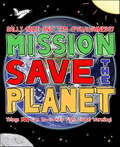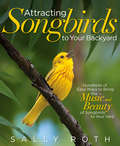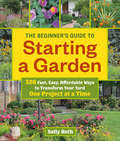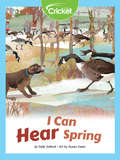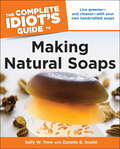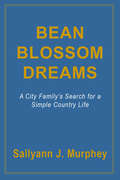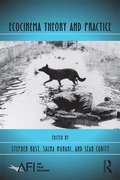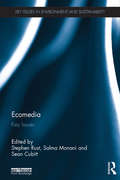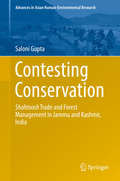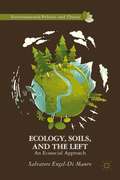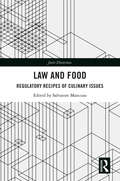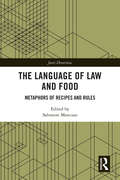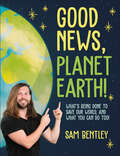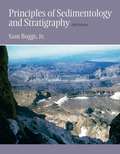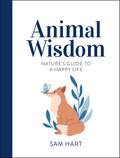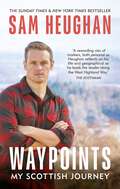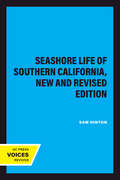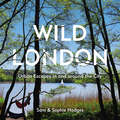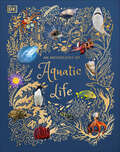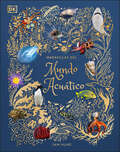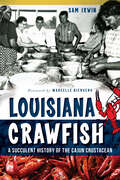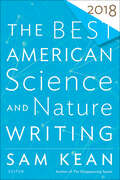- Table View
- List View
Mission: Save the Planet
by Sally Ride Tam O'ShaughnessyPRACTICAL STEPS TO SAVE THE PLANETA how-to companion packed with simple things kids can do to have an impact.From simple measures like turning off the water while you brush your teeth, to bigger challenges like MAKING SOME NOISE in the larger community, this simple guide helps lay a conceptual foundation for kids to become responsible energy consumers in the years to come.
Attracting Songbirds to Your Backyard: Hundreds Of Easy Ways To Bring The Music And Beauty Of Songbirds To Your Yard
by Sally RothThe best ways to attract melodic birds, with insight into their rapidly changing habits The American robin and northern cardinal are two of the best-loved songbirds, but newer backyard arrivals, like rose-breasted grosbeaks and scarlet tanagers, quickly captivate with their vivid colors and unique songs. Bird lovers will learn to attract new visitors by offering treats that songbirds like best, such as soft, easy-to-peck foods that closely mimic caterpillars, their top food preference. And planting just a few carefree perennials and shrubs can provide opportunities for cover and nesting. Sally Roth's Attracting Songbirds to Your Backyard draws on the latest science and 50 years of observation to reveal these fascinating details: • In the wee hours, it's the robins that sing first, followed by the babble of house wrens and the whistle of cardinals • Some birds learn birdsongs throughout their lives, while others stop learning once they can mimic their parents' song • It's Dad, not Mom, who teaches the young birds to sing Simple tips, ideas, and recipes, as well as an understanding of why songbirds are coming from the treetops into the backyard, will help any bird enthusiast create a songbird sanctuary.
The Beginner's Guide to Starting a Garden: 326 Fast, Easy, Affordable Ways to Transform Your Yard One Project at a Time
by Sally RothA fresh approach and simple way to transform your yard! The prospect of revamping a yard is daunting. Where do you start? How do all the various areas come together in a beautiful, cohesive way? The Beginner’s Guide to Starting a Garden simplifies the process by showing you how to spend fewer hours (and a minimal amount of money) in the garden by tackling one small area at a time. You’ll find garden plans for ten unique areas—the entryway, the shady areas under trees, and more—that can be linked together over time to create a unified yard, and plants that are dependable, easy to find, and look good year after year. You’ll also learn the basics of good design, which plants offer the most bloom for your buck, and how to avoid the most common planting mistakes.
I Can Hear Spring
by Sally SelleckHow do you know that spring is finally coming? The geese, of course! All you have to do is look for the V-shape in the sky and listen for all that honking as they migrate back from Canada!
The Complete Idiot's Guide to Making Natural Soaps: Live Greener—and Cleaner—with Your Own Handcrafted Soaps
by Sally Trew Zonella B. GouldLeave no soapstone unturned! Soapmaking has always been a popular craft with a dedicated group of followers, but with the explosion of urban homesteading and people looking to go green, noncrafters are now joining in on the fun. Whether it's making natural soap to live greener, give as gifts, save money, or make money, The Complete Idiot's Guide® to Making Natural Soaps has everything the new soap maker will need to create organic, natural soaps of all kinds. • Includes recipes to make a wide array of molded, poured, and liquid soaps • Contains soap recipes for body as well as household and even pets
Bean Blossom Dreams
by Sallyann J. MurpheyIt started with 200 pounds of tomatoes harvested from a tiny plot of polluted Chicago dirt. It ended with a new a new life on a broken down farm in Brown County Indiana, where the Murphey family settled, trading the urban fast track for a simpler existence. This book chronicles the Murpheys' first 2 years at Bean Blossom Farm - a luminous portrait of how one family made their American Dream come true."With an incredible eye for detail, Murphey offers insight into the differences in country vs. city living."- Rocky Mountain News"Delighful."- New York Newsday"For those who dream of living in the country or those who already do, this is a delightful book, full of good humor, wisdom, and personal honesty."- The New Garden Journal
Ecocinema Theory and Practice (AFI Film Readers)
by Sean Cubitt Stephen Rust Salma MonaniEcocinema Theory and Practice is the first collection of its kind—an anthology that offers a comprehensive introduction to the rapidly growing field of eco-film criticism, a branch of critical scholarship that investigates cinema’s intersections with environmental understandings. It references seminal readings through cutting edge research and is designed as an introduction to the field as well as a sourcebook. It defines ecocinema studies, sketches its development over the past twenty years, provides theoretical frameworks for moving forward, and presents eloquent examples of the practice of eco-film criticism through essays written by the field’s leading and emerging scholars. From explicitly environmental films such as Werner Herzong's Grizzly Man and Roland Emmerich's The Day After Tomorrow to less obvious examples like Errol Morris's Fast, Cheap & Out of Control and Christopher Nolan's Inception, the pieces in this collection comprehensively interrogate the breadth of ecocinema. Ecocinema Theory and Practice also directs readers to further study through lists of recommended readings, professional organizations, and relevant periodicals.
Ecomedia: Key Issues (Key Issues in Environment and Sustainability)
by Sean Cubitt Stephen Rust Salma MonaniEcomedia: Key Issues is a comprehensive textbook introducing the burgeoning field of ecomedia studies to provide an overview of the interface between environmental issues and the media globally. Linking the world of media production, distribution, and consumption to environmental understandings, the book addresses ecological meanings encoded in media texts, the environmental impacts of media production, and the relationships between media and cultural perceptions of the environment.Each chapter introduces a distinct type of media, addressing it in a theoretical overview before engaging with specific case studies. In this way, the book provides an accessible introduction to each form of media as well as a sophisticated analysis of relevant cases. The book includes contributions from a combination of new voices and well-established media scholars from across the globe who examine the basic concepts and key issues of ecomedia studies. The concepts of "frames," "flow", and "convergence" structure a dynamic collection divided into three parts. The first part addresses traditional visual texts, such as comics, photography, and film. The second part of the book addresses traditional broadcast media, such as radio, and television, and the third part looks at new media, such as advertising, video games, the internet, and digital renderings of scientific data. In its breadth and scope, Ecomedia: Key Issues presents a unique survey of rich scholarship at the confluence of Media Studies and Environmental Studies. The book is written in an engaging and accessible style, with each chapter including case studies, discussion questions and suggestions for further reading.
Contesting Conservation
by Saloni GuptaThis book explores today’s changing intellectual climate, wherein understanding politics at different levels from global to local is considered mandatory in order to appraise the outcome of nature conservation interventions. By carefully examining two such processes – the ban on shahtoosh trade and the ‘National Afforestation Programme’ in the Indian state of Jammu and Kashmir, the book reveals how these processes are influenced by politics at different levels – from their introduction at the macro-level to their implementation at the micro-level – and in turn become coloured by the agendas and interests of the various stakeholders involved. Throughout the book, one priority is to give a voice to the poor resource-users who have been traditionally dependent on wildlife and forest resources for mere subsistence. Yet, these same people are who bear the brunt of nature conservation costs, rather than those actors who are responsible for the most serious violations in pursuit of greater profits. Contemporary Environmental Sociology is chiefly characterised by its focus on power relations in resource conservation and management. In ‘political ecology’ literature, too – especially after recognising the paradoxes and limitations of approaches such as ‘sustainable development’, ‘sustainable livelihoods’ and ‘community based natural resource management’ – there is a growing concern for critical analyses of multi-level politics in connection with nature conservation. The purpose of the book is not to challenge the gravity of environmental concerns, but to question the dominance of conservation interests over the subsistence needs of local communities, and to strike a balance between environmental and social justice. It argues that, unless and until more just accountability for the affected populations is ensured, conservation policies are unlikely to meet the goals of sustainable resource management. Given its critical engagement with human-nature conflicts in Jammu and Kashmir, the book offers a unique resource for students and scholars of Environmental Sociology, Political Ecology, Natural Resources Management, Conflict Studies and Human Rights Studies.
Ocean Sustainability in the 21st Century
by Salvatore AricòDescribing the emerging and unresolved issues related to the oceans and the marine environment, this book presents the developments made in marine science and policy since the implementation of the United Nations Convention on the Law of the Sea (UNCLOS), and implications for the sustainable management of ocean areas and resources. This comprehensive volume also provides a number of scientific, policy, and legal tools to address such issues, and to ensure better science-based management of the oceans. Topics covered include the impacts of human-induced climate change on the oceans, the marine genetic resources debate, the current legal framework for the oceans, and a comparative study of the legal issues associated with outer space. Including practical examples and worldwide case studies, this book is a valuable resource for policy makers, students and academics, in marine science and policy, ocean affairs, and the law of the sea.
Ecology, Soils, and the Left
by Salvatore Engel-Di MauroSoil degradation is real and global, even if the evidence is not so easy to glean. Degradation poses comparable risks to greenhouse gas emissions, deforestation, and nonhuman animal extinctions. Few have noticed soil degradation as the problem it has become, except most indigenous peoples in their struggles for survival.
Law and Food: Regulatory Recipes of Culinary Issues (Juris Diversitas)
by Salvatore MancusoThis book presents a range of insights on the relationship between food and law. Over time, religions have multiplied food prohibitions and prescriptions, customs have redistributed land, shared its occupancy in creative ways, or favoured communal property so that everyone could have access to food. In turn, laws have multiplied to facilitate food trade, security, safety, traceability, and also to promote and protect food and wine production, using trademarks and geographical denominations. This volume brings a comparative and interdisciplinary approach to examine some of the most heavily debated issues in the interaction between food, in all forms, and the law. Topics covered include food security, food safety, food quality, intellectual property, and consumer protection. As well as highlighting current issues, the work also points to new challenges in this field. The book will be a valuable resource for researchers and policy-makers working in the area of Food Law and Comparative Law.
The Language of Law and Food: Metaphors of Recipes and Rules (Juris Diversitas)
by Salvatore MancusoThis book reconsiders the use of food metaphors and the relationship between law and food in an interdisciplinary perspective to examine how food related topics can be used to describe or identify rules, norms, or prescriptions of all kinds. The links between law and food are as old as the concept of law. Many authors have been using such links in creative ways to express specific features of law. This is because the language of food and cooking offers legal thinkers and teachers mouth-watering metaphors, comparing rules to recipes, and their combination to culinary processes. This collection focuses on this relationship between law and food and takes us far beyond their mere interaction, to explore different ways of using these two apparently so diverse elements to describe different phenomena of the legal reality. The authors use the link between food and law to describe different aspects of the legal landscape in different areas and jurisdictions. Bringing together metaphors and indirect correlations between law and food, the book explores different models of approaching legal issues and considering different legal challenges from a completely new perspective, in line with the multidisciplinary approach that leads comparative legal studies today and, to a certain extent, revisiting and enriching it. With contributions in English and French, the book will be of interest to academics and researchers working in the areas of law and food, law and language, and comparative legal studies.
Experiments with Plants: A True Book
by Salvatore TocciNine easy-to-follow experiments help readers explore what a plant is, what it needs to grow and live, what's inside a plant seed, and how seeds grow and get spread in the wild.
Good News, Planet Earth: What’s Being Done to Save Our World, and What You Can Do Too!
by Sam BentleyJoin sustainability enthusiast and climate activist Sam Bentley as he shares the hopeful developments combating climate change!Do you feel like climate change is just getting worse and there's nothing you can do to stop it? Good news—there are tons of efforts already underway to save our planet, and we'd love for you to join the fight.Good News, Planet Earth! is your go-to guide to learn all about the amazing sustainable developments that are happening worldwide to combat global warming, pollution, deforestation, the use of wasteful products, and threats to our diverse wildlife.Inside you'll find:· 25 chapters covering ocean-cleanup innovations, composting initiatives, animal rights activism, efforts to greenify public spaces, solar power advancements, public transportation solutions, and more!· 100 actionable steps you can take to fight climate change and live more sustainably!An uplifting and informative call to action for any environmentally conscious individual, Good News, Planet Earth! is the small but mighty book that might just help save the world!
Principles of Sedimentology and Stratigraphy (Fifth Edition)
by Sam BoggsThis concise treatment of the fundamental principles of sedimentology and stratigraphy highlights the important physical, chemical, biological, and stratigraphic characteristics of sedimentary rocks. It emphasizes the ways in which the study of sedimentary rocks is used to interpret depositional environments, changes in ancient sea level, and other intriguing aspects of Earth's history.
Animal Wisdom: Nature's Guide to a Happy Life
by Sam HartSelf-care gone wild Slow down like a sloth, stretch like a cat, breathe deep like a whale and have the confidence of a lion. When life gets you down, lift your spirits with these tiny tips and helpful hints from our friends in the animal kingdom.
Waypoints: My Scottish Journey
by Sam HeughanAN INSTANT SUNDAY TIMES AND NEW YORK TIMES BESTSELLER'As the title suggests, Waypoints is a rewarding mix of markers, both personal as he reflects on his life and geographical as he leads the reader along the West Highland Way' - The Scotsman'A deeply personal and warmly entertaining memoir that fans of Sam - and Scotland - will have a joyful time devouring' - Heat'From both his walk and his career, the common lesson is the power of persistence.' - The Times'A pleasure for fans of the author, whisky, and Scotland.' - Kirkus'Waypoints is a memoir with a difference! I wanted to tell the stories and share the experiences that have shaped me, but to do that I needed to challenge myself and spend some time in my own company, away from the distractions of everyday life. And for me there's no better place to reflect than in the wild Scottish Highlands.'In this journey of self-discovery, Sam Heughan sets out along the West Highland Way to explore his heritage and reflect on the personal waypoints that define him. The result is a love letter to the wild Scottish landscape that means so much to Sam, and a charming, funny, wise and searching insight to the world through his eyes. The walk itself is the backdrop for this narrative, which tells the story of Sam's life while exploring his outlook, values and interests. Sam is a figure of fascinating contrasts, a Hollywood star with deep roots in rural Scotland, he's both outgoing and content in his own company. He has strong connections with his fans while recognising the fragility and value of anonymity, and in My Peak Challenge he has created a network that brings people together as they chase individual goals. In his new book, while charting a path through a stunning wilderness, Sam maps out the moments that shaped his views on dreams and ambition, family, friendships, love and life.Waypoints is a deeply personal journey that reveals as much to Sam about himself as it does to his readers.
Seashore Life of Southern California, New and Revised edition (California Natural History Guides #26)
by Sam HintonThe dry land is one world and the wet sea is another, but the line separating them is ever-changing. Known as the intertidal zone, the area between the land and the sea is defined by the extremes of the tides. Sam Hinton provides an introduction to this fascinating zone and its contiguous waters and to some of the many creatures who make the southern California seacoast their home. This highly readable book has been for many years the handiest resource available for anyone wanting to explore that region's delights and mysteries. The book is filled with interesting anecdotes and drawings and has a thorough discussion of the natural forces¯the tides, winds, storms, currents, surf, and ocean chemistry¯that affect near-shore animals. Also included is a section relating the ocean forces to the intertidal habitat, along with a map of southern California locations where one might observe the organisms described in the book.
Wild London: Urban Escapes in and around the City
by Sam Hodges Sophie HodgesFrom the authors of London for Lovers, this is an inspiring and comprehensive guide to London’s wild side. From exploring secret gardens, parks, farmers markets and city farms, to discovering the best spots for urban bee-keeping, foraging, open-air swimming and mudlarking, Wild London is packed with ideas for how to make the most of London’s hidden natural wonder. Separated by season, and filled with stunning photographs, this is a must-have, practical and eye-opening guide to alternative London for city-dwellers and visitors alike.
An Anthology of Aquatic Life (DK Children's Anthologies)
by Sam HumeDive into the wondrous world of water and discover the stories of more than 100 incredible aquatic lifeforms.The underwater world is so much bigger than young minds can fathom and there is always more to learn. An Anthology of Aquatic Life is a stunning ocean encyclopedia for young readers to explore, with reference pages packed with fascinating information, little learners will be captivated as they discover the facts, stories and myths behind their favourite sea-life animals. From the deepest, widest ocean to the tiniest puddle, this beautiful compendium takes young readers on an enthralling journey through the aquatic world, meeting amazing animals, ingenious plants, and much more along the way. Stunning photography and gorgeous illustrations complement storybook descriptions about each lifeform, and children can uncover hundreds of fascinating facts as they read. Did you know that elephant seals can hold their breath underwater for more than an hour, or that the brown basilisk reptile can run across water? Discover the science of how plants have learnt to live, feed, and breathe in water, and take a look at the unique challenges of distinct ecosystems on feature spreads about rivers, lakes, wetlands, and more. Celebrate your child&’s curiosity as they:- Explore detailed photographs and striking illustrations of nature in action- Reveal fun facts and myths about how a range of animals and plants adapt to their environments- Uncover more than 100 aquatic lifeforms, each with stunning images and captivating information.This ocean encyclopedia for children is the perfect blend of storybook style text with out of this world illustrations which makes it a fantastic sea life book for children who are obsessed with the underwater world. Encourage young readers to go on a journey to explore a world of information, making this the ideal first reference book for kids aged 7-9 to enjoy for hours on end, whether reading with the family or reading alone, this fun fact book also doubles up as the perfect gift for curious kids who love to learn. Explore the diversity of the animal kingdom whilst uncovering: -Stunning Jacket Detail: gold foil, holographic foil & metallic gold edges-Stunning photography & illustrations inside-A beautiful book for the whole family to treasure -A quality gift to be passed down through the generationsMore in the SeriesAnthology of Aquatic Animals is part of the beautiful and informative Anthology series. Complete the series and nurture your child's curiosity as they explore the natural world with The Wonders of Nature or let them walk with the dinosaurs who ruled the earth before them in Dinosaurs and other Prehistoric Life.
Maravillas del mundo acuático (DK Children's Anthologies)
by Sam HumeDesde el océano más ancho y profundo hasta el charco más pequeño, este hermoso álbum lleva a los niños lectores por un viaje fascinante a través del mundo acuático, en el que conocerán animales increíbles, plantas ingeniosas y mucho más. Impresionantes fotografías y hermosas ilustraciones complementan las descripciones de cada forma de vida, con las que los niños descubrirán cientos de datos interesantes mientras leen. ¿Sabías que los elefantes marinos pueden contener la respiración bajo el agua durante más de una hora, o que la planta acuática Victoria Cruiziana puede soportar el peso de un adulto, o que el reptil basílisco (teterete) puede correr sobre el agua?Descubre la ciencia de cómo las plantas han aprendido a vivir, alimentarse y respirar en el agua y echa un vistazo a los desafíos únicos de los diferentes ecosistemas, las características de los ríos, lagos, humedales y más. Contiene un índice visual lleno de información de referencia, con el tamaño y hábitat de cada especie.Con una elegante cinta marcapáginas y detalles dorados en la portada y en los bordes, 'Maravillas del mundo acuático' es un regalo atractivo para cualquier niño que le encante el mundo natural, ideal para que los más pequeños exploren por sí mismos o para leer cuentos a la hora de acostarse. Desde tiburones y peces vela hasta juncos y escarabajos, hay algo para todos en esta celebración de todas las cosas acuáticas.From the deepest, widest ocean to the tiniest puddle, this beautiful compendium takes young readers on an enthralling journey through the aquatic world, meeting amazing animals, ingenious plants, and much more along the way. Stunning photography and gorgeous illustrations complement storybook descriptions about each lifeform, and children can uncover hundreds of fascinating facts as they read. Did you know that elephant seals that can hold their breath underwater for more than an hour, or that the Victoria Amazonica water lily can support the weight of an adult, or that the brown basilisk reptile can run across water?Discover the science of how plants have learned to live, feed, and breathe in water, and take a look at the unique challenges of distinct ecosystems on feature spreads about rivers, lakes, wetlands, and more. There&’s also a visual index, packed with reference information including the size and location of each species.With foil on the cover, gilded edges, and a ribbon for keeping your place, 'Maravillas del mundo acuático' makes an attractive gift for any child who can&’t get enough of the natural world – and it&’s perfect for young readers to explore by themselves or for bedtime stories. From sharks and sailfish, to bulrushes and beetles, there&’s something for everyone in this celebration of all things aquatic.
Louisiana Crawfish: A Succulent History of the Cajun Crustacean (American Palate)
by Sam IrwinThe hunt for red crawfish is the thing, the raison d'etre, of Acadian spring. Introduced to Louisiana by the swamp dwellers of the Atchafalaya Basin, the crawfish is a regional favorite that has spurred a $210 million industry. Whole families work at the same fisheries, and annual crawfish festivals dominate the social calendar. More importantly, no matter the occasion, folks take their boils seriously: they'll endure line cutters, heat and humidity, mosquitoes and high gas prices to procure crawfish for their families' annual backyard boils or their corporate picnics. Join author Sam Irwin as he tells the story--complete with recipes and tall tales--of Louisiana's favorite crustacean: the crawfish.
The Best American Science And Nature Writing 2018 (The Best American Series)
by Sam Kean, Tim FolgerA collection of the year’s best science and nature writings, selected by New York Times bestselling author Sam Kean.“This is one of the most exciting times in the history of science,” Sam Kean proclaims in his introduction to The Best American Science and Nature Writing 2018. “Things aren’t perfect by any means. But there are more scientists making more discoveries in more places about more things than ever before.” The twenty-six pieces assembled here chart the full spectrum of those discoveries. From the outer reaches of space, to the mysteries of the human mind, to the changing culture in labs and universities across the nation, we see time and again the sometimes rocky, sometimes revelatory road to understanding, and along the way catch a glimpse of all that’s left to learn.The Best American Science and Nature Writing 2018 includes contributions by Ross Andersen * Jacqueline Detwiler * Sophie Brickman * John Lanchester * Siddharta Mukherjee * Kim Todd * Douglas Fox * J. B. MacKinnon * Barack Obama * David Roberts * Ceridwen Dovey * Caitlin Kuehn * Paul Kvinta * Joshua Rothman * Christopher Solomon * Kayla Webley Adler * Rachel Leven * Rebecca Boyle * Kenneth Brower * Susannah Felts * Steven Johnson * Elena Passarello * Ed Yong * Barbara Bradley Hagerty * Eva Holland * Kathryn Schulz

